All about Birds
Red Faced Duck? Meet The Far From Ordinary Muscovy Duck!
Maybe you landed on this page because you’re looking to identify red faced duck?
It’s also known as a Muscovy Duck:
This large, peculiar-looking duck is native to Mexico, Central, and South America.
And here’s what you need to know about it…
A Quick Overview Of The Red Faced Duck (Muscovy Duck)
The red faced duck’s size and long necks fool people into believing that they’re geese but they’re not.
Saying that they’re not technically ducks either.
They’re their own unique species.
They can now be found in many different countries such as Australia, New Zealand and certain parts of Europe.
The domesticated species can usually be spotted waddling around areas close to ponds and rivers.
Although they originate from warmer climates, they have adapted to survive in climates as cold as -12 degrees.
See Also: Bird Symbols: What Are The Spiritual Meanings Of Birds?
The Muscovy Duck, or the Red Faced Duck as it’s sometimes known, has the scientific name Cairina moschata.

There are different types of these birds, including domesticated and feral ones, each type varies slightly in appearance.
On average they are larger than a Mallard and smaller than a Canada Goose. They like to dabble for food in shallow water and socialize with other Muscovy’s.
Unlike traditional ducks, the Muscovy Duck doesn’t “quack.” In fact, this duck doesn’t make much sound at all, as it prefers to opt for a quieter life.
Do They All Have Red Faces?
It’s mostly the male species of Muscovy Duck that have red, wart-like bumps on their faces.
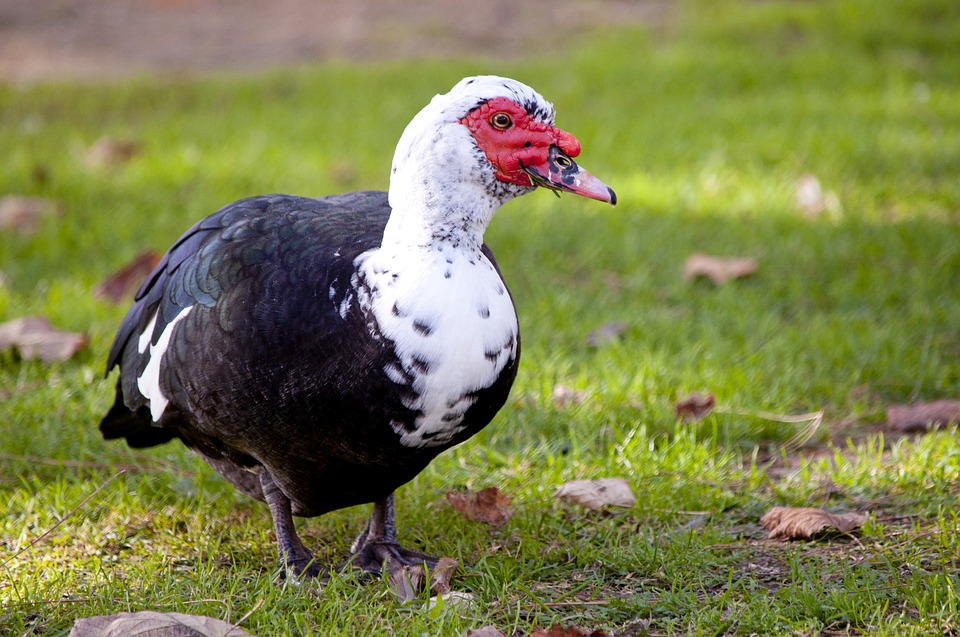
Some females still have them, especially the feral ones.
The domesticated female Muscovy Duck has mostly dull black feathers with a few white patches and they don’t have any red wart-like bumps.
The feral species generally have more of these bumps than the domesticated but this isn’t always the case.
The juvenile ducks don’t have any of the red bumps and their feathers are duller in appearance than the females.
Evolution Of The Red Faced Duck
The world has changed dramatically and because of this, the bird world has changed too.
With an ever-changing world, how has the Muscovy Duck adapted to fit into their surroundings?
Adaptations
In the wild they’re strong flyers. The ability to fly swiftly away from trouble can be life-saving for them when that pesky prey is about.
Their clawed feet make it easy for them to move about on land.

They have waterproof feathers so regardless of the weather they will stay warm and insulated. This also means they can thrive in both warm and cold climates.
Their strong, flat bills make them experts at dabbling to catch insects, fish, and crabs below the water.
The Red Faced Duck Lifestyle and Health
How do these red-faced birds stay happy and healthy? Read on to find out how these ducks thrive in their environments.
Life Expectancy
In the wild they have an average lifespan of between 8-12 years.
While domestic Muscovy Ducks don’t face the same threats from predators and diseases so they can live up to 20 years.
How They Like Spending the Day?
Muscovy Ducks love to perch in tall trees and watch the world go by.
Domesticated breeds like to wander around ponds and see what’s going on.
Fun Facts About The Muscovy (Red Faced Duck)
Are you fascinated by this peculiar looking bird? Are you desperate to learn more about them?

Here are some amazing fun facts so you can learn something new about this fascinating species of bird that you didn’t know before.
Amazing Fun Facts
Although they like to roam around ponds and rivers, the Muscovy Duck doesn’t actually swim all that much, as they have underdeveloped oil glands.
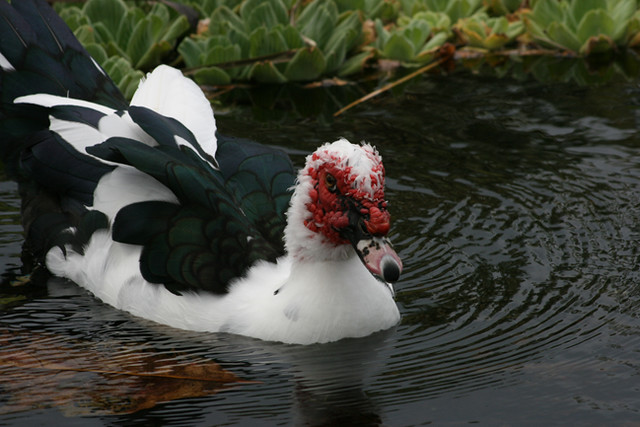
Their average lifespan is 8-12 years. Although, Muscovy’s in captivity can live up to 20 years.
They love to wag their tails. In fact, they do this when they’re happy, excited and also when they annoyed.
Although they don’t quack and they usually remain pretty quiet, an angry male Muscovy Duck can puff and hiss.
Amazing Fun Facts Continued
The domesticated Muscovy Duck is the only breed of duck (although they’re not technically a duck) in the world that hasn’t been bred from Mallard stock.
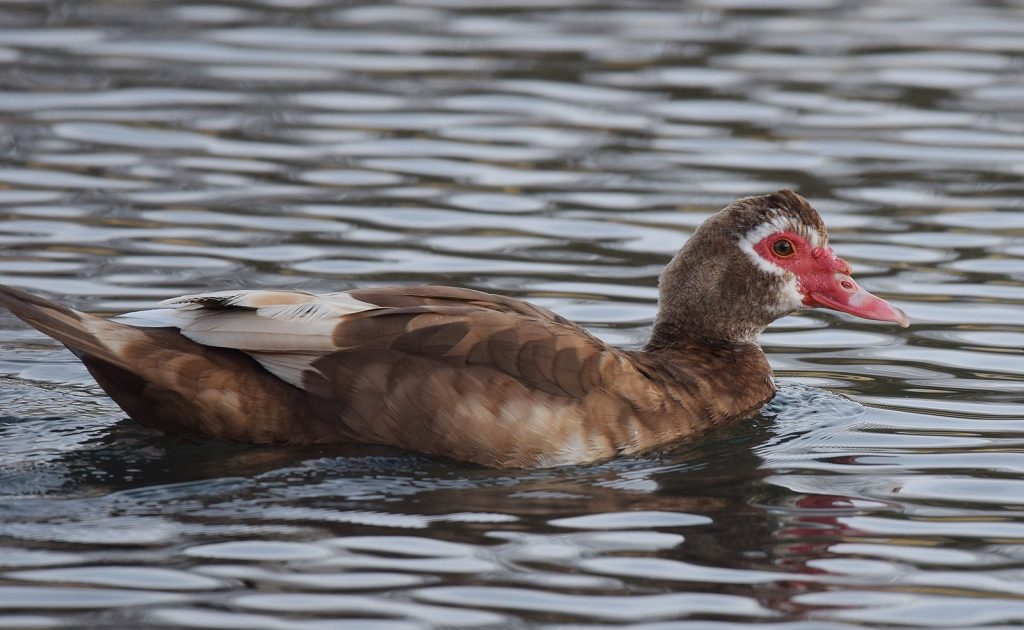
It’s advisable not to get too close to one, as they have a ridge to their beak that can tear the skin off… Ouch!
If you’re out and about and you happen to spot a group of ducks there are quite a lot of collective nouns you can use to describe them.
Now, isn’t that a lovely “flush of ducks,” oh I do hope that “team of ducks,” will stay around for awhile. (yes, I know that the Muscovy isn’t technically a duck but they look like one and this is a great fact.)
Behavior
This bird species isn’t the most talkative, doesn’t swim all that much and has more resemblance to a goose.
How Muscovy Ducks act in the wild as opposed to pets is different, but domesticated and wild breeds of this species also share some similar behavior traits.
Behavior in the Wild
The odd-looking birds are often seen waddling about in pairs. They aren’t monogamous and have multiple partners.
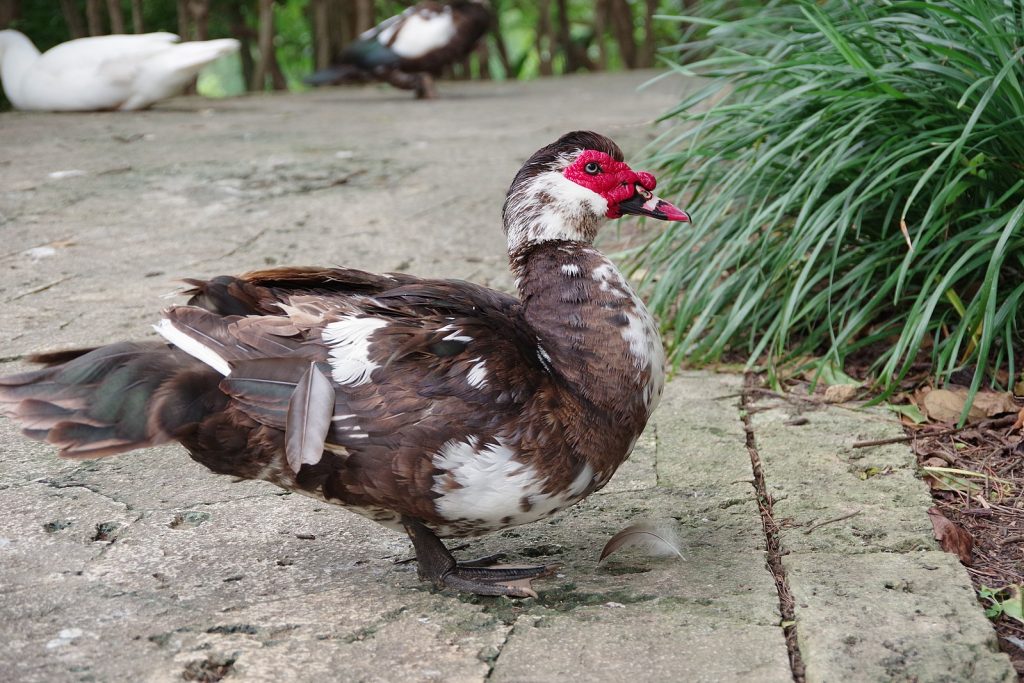
They sometimes breed with Mallards and produce hybrids known as the “Mule Duck,” thus called because they’re sterile.
The males like to hiss at each other and can act aggressively.
However, they don’t protect their territory or the nests of their young, instead this is down to the female.
They’re wary of humans and will try to avoid them. They perch on tree branches that aren’t too far from the ground and they prefer to roost in small groups.
Domesticated Behavior
The domesticated Muscovy Ducks still has multiple partners and they like to hiss at each other…some things never change!
The main difference between them to their wild relatives is that they aren’t so wary of humans. They like to wander around ponds and accept food offerings from humans.
They’re also useful to have around as they’re excellent bug catchers.

Companionship
Muscovy Ducks aren’t loyal partners, in fact, they will bread with multiple birds, including mallards.
They don’t like to be alone and are often seen out and about in pairs.
They also like to fly in groups.
Physical Characteristics
Their interesting appearance certainly gets them noticed but there’s far more to this bird than the red bumps on their face.
Size
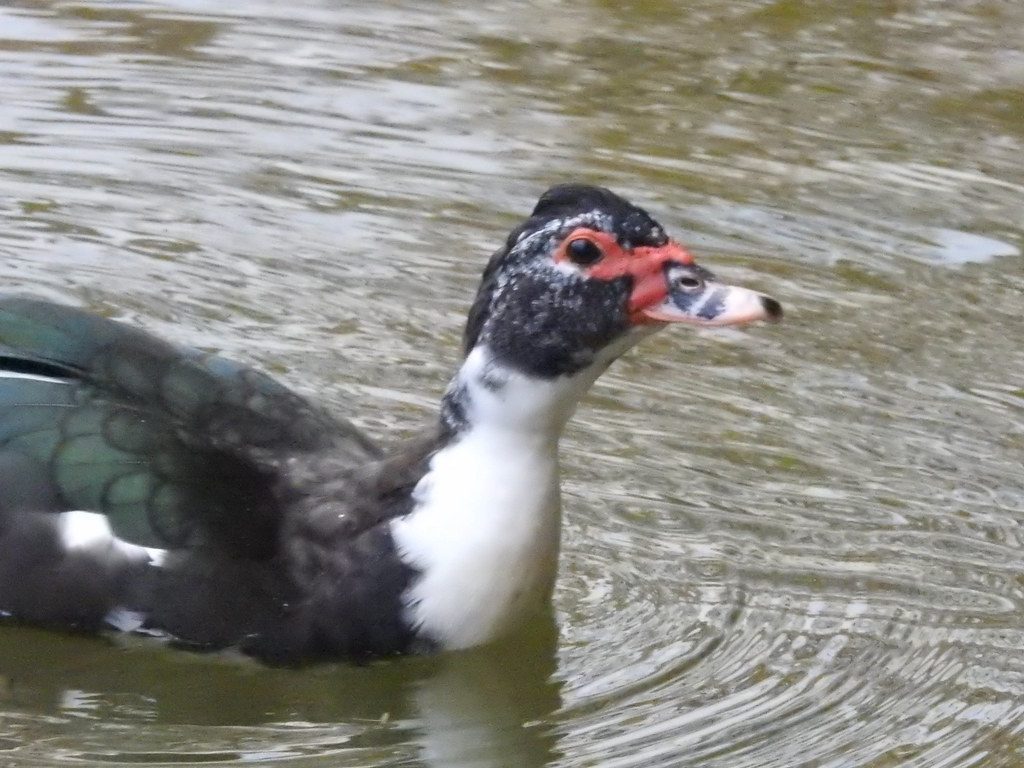
Domesticated females are far smaller than the domesticated males.
The length of the females are no more than 25 inches, while the males are around 34 inches.
Wild Muscovy Ducks are between 26-33 inches long, and they have a wingspan range of between 54-64 inches.
Weight
Domesticated females weigh between 6-7.9lbs, while domesticated males weigh between 10-15lbs.
The weight of a wild Muscovy Duck can range anywhere from 2.4-9lbs.
Habitat

We all have different places that we like to call our home.
For us, we can choose between living in a house or an apartment, the country or the city.
Muscovy Ducks can also choose where they want to inhabit.
Influenced by their surroundings they choose to call woodland areas, lagoons, marshes and nest boxes their homes.
Favorite Habitat
Both wild and domesticated Muscovy Ducks like to be close to water. Not being swimming fanatics doesn’t stop them from finding enjoyment out of being by ponds and rivers.
Wild birds like areas with dense vegetable and tall trees. A grass covered swamp close to a pond or river sounds like their idea of bliss!
What are Their Housing Enclosure Requirements?
Domesticated Muscovy Ducks are quiet, easy to care for and generally just get on with it.

However, they don’t cope well with small confinements.
They like to swim, fly and give the neighbor an occasional visit.
Make sure you provide them with a hut so they can seek shelter in bad weather.
They also need a perch, as this is one of their favorite pastimes.
Even though they aren’t big swimmers like love being close to water, so providing with some source of shallow water is preferable to keep your birds happy.
FAQs – The Short Answers
Do you still have loads of questions about this funny looking breed of bird? Don’t worry, as I’m going to answer the most frequently asked questions about these bumpy, red-faced hissers.
Question 1 – What are Muscovy Ducks Used For?
The domesticated Muscovy Ducks are used for breeding. They’re commonly crossed with Mallard Hens.
The young produced are sterile and are therefore generally bred for their meat. These hybrids grow as fast as a Mallard but as large as a Muscovy.
Question 2 – Do Muscovy Ducks Need Shelter?
If you have them as pets you’ll need to make them a shelter to protect them from predators and the elements.
The Muscovy Duck needs a roosting area, as one of their favorite pastimes is to perch.
Question 3 – How Well do They Fly?
Domesticated Muscovy Ducks aren’t the greatest flyers, as they’ve been bred so they can’t sustain flight for long.
However, in the wild they’re expert flyers, who like to nest between 10 and 60 feet up in the trees.
Due to their smaller size, the females find it easier to fly higher off the ground. They like to fly in groups and can often be spotted flying during dust or the dawn.
When flying they hold their neck straight like a goose does.
Question 4 – What Predators do They Have?
These placid birds are on the dinner list for many predators.
Although the Muscovy Duck can hiss and nip at its predators, they aren’t the most ferocious of birds, which makes them susceptible to many attacks.
Some of the their predators are dogs, foxes, minks, skunks, herons and owls.
Question 5 – Where do They Build Their Nests?
Muscovy Ducks choose to build their nests in the hollows of trees, large nest boxes, or on some occasions on dense ground.
It’s down to the female to mind the nest. It’s also normal for her to be faithful to a single nest during her lifetime.
Question 6 – What do They Eat?
Muscovy Ducks like to feed in shallow water, by dabbling, which is great for catching small crabs and organic matter…yum!
They’re also partial to insect larvae, seeds, spiders and worms.
Question 7 – How Often do They Lay Eggs?
Alot! In fact, they lay around 180 eggs a year and usually hatch about 4 sets of younglings.
Each clutch size is between 8-15 eggs. The incubation period lasts for around 30 days.
Each egg is glossy white and some have a greenish tint to them.
Question 8 – Do They Migrate?
No, they don’t migrate. This is mainly down to the fact that they can thrive in both warm and cold climates.
They will only move location in they don’t have a prominent water source.
Question 9 – What are the different types of Domesticated Muscovy Duck?
The domesticated of these species can be easily told apart by the red bumps on their faces. They may all share these similarities but they come in many different varieties of colors.

If you see one of these domesticated birds at your local pond then they may be black, blue, chocolate, lavender, white and bronze.
It’s common for one of these birds to be a mix of colors, such as white, black and blue.
An Overview to the Muscovy Duck

I hope that you now know everything you wanted to know about this peculiar duck (that isn’t actually a duck!).
They’re fascinating birds with distinctive markings, odd quirks and plenty of character.
Being one of the oldest birds in the world might not make them all that wise, but they are certainly unique looking.
They add some dabbling, hissing, roosting fun to everything and are proof of how broad and fascinating the bird world is.

